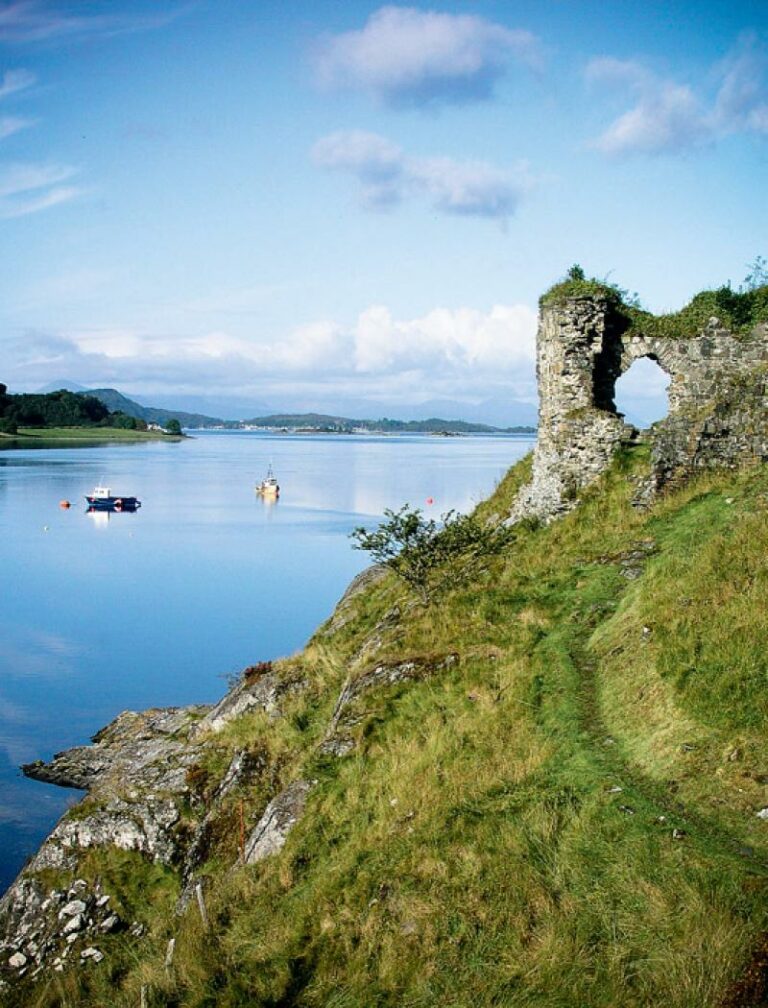
Leaping cetaceans accompany the boat as JANE WILKINSON heads out to enjoy another days colourful reef diving in seductive Loch Carron, in Scotlands north-west highlands
SKIPPER DAVE Black is in the unique position of being able almost to guarantee a dolphin sighting from his RIB in Loch Carron. Revving the engine, we shot off down the loch – a clear signal for the dolphins!
As we drew level with the fish-farm, we could see streaks of white as the dolphins began to zigzag in front of the bow, leaping out of the water and slapping their tails, before plunging back into the loch. It’s a spectacular joy to behold in such a scenic setting.
Several years ago, three dolphins arrived in Loch Carron, a mother and two babies. It was thought that she had bought them to the loch as a refuge. However, shortly afterwards, three dolphins became two, and the orphans made Loch Carron their home.
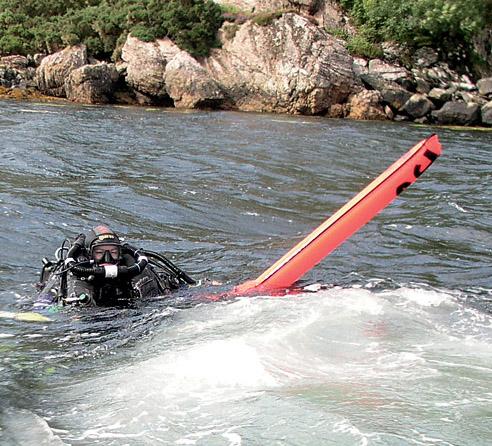
The thrill of watching this pair jumping and cavorting within touching distance was a treat, but better was still to come.
Most of the small village of Lochcarron lies stretched out along the road that runs the length of the loch. This gives many of the inhabitants a superb view over a body of water that teems with marine life, and nowhere is this more evident than in the spectacular Conservation Bay.
While it is possible to do this as a shore dive, a boat not only gives you the opportunity to see more of this site, but also to do it in greater safety.
It’s easy to venture a little too far here and be whisked away by the fierce tidal streams that race through the narrows. The shortness of slack on spring tides can also catch out the unwary diver.
From the shore, enter the water down a shingle beach after climbing down the slope above. Swim out following the wall on the left, or drop in off the boat, swimming down to the bottom of the wall.
The bay itself is a no-take zone.
This might explain the huge size of the edible crabs found clinging to the walls, which are covered in clumps of pink featherstars and delicate peacock worms.
Shore divers really need to return once they reach the plaque on the wall, which was placed there in memory of a local diver. After this point strong currents can take you by surprise, or even prevent you returning.
Swim beyond the plaque, however, and the rocky walls start to become smothered with a multitude of yellow and creamy-coloured dead men’s fingers.
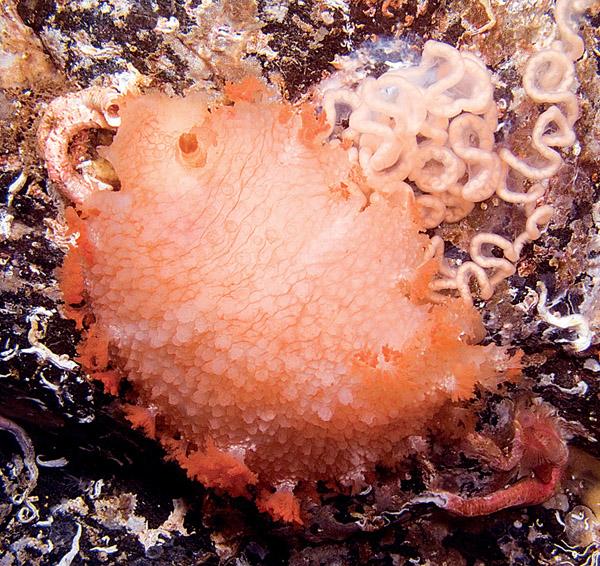
It’s a feasting ground for huge, brightly coloured Triton hombergi, commonly known as dead men’s finger sea slugs; I was lucky enough to be diving while they seemed to be laying their wiggly strings of eggs.

Don’t neglect the seabed here, which is alive with hairy brittlestars and ghostly white sea cucumbers.
These beautiful creatures slowly curl up their tentacles like beckoning fingers as they catch minute particles of food.
Along the south side of the loch, beneath the road and railway and accessible only by boat, are boulder slopes that drop down to 30m before continuing with a muddy, silty bottom.
Some of these continue to plummet to 70m and more in places.
A good place to drop in is Cuddies Point, so-called because of the fish that can be found there.
Swim down over the weed to find huge wrasse and pollack, in addition to the small cuddies [saithe] with their characteristic white bellies.
Further down at around 25-30m, you find tall sea-pens. You might even see a sinuous ling swimming in and out of them before returning further up to continue its search over the rocks, covered with fluted sea-squirts and urchins.
Further west beneath the avalanche shelter (built to protect the road above), the boulders become covered with plump, red sea-squirts and the perfect spheres of football sea-squirts.
These individual squirts grow closely together to form a colony that can be as big as a football.
Hundreds, if not thousands, of long-clawed squat lobsters wave their claws threateningly from every crack and crevice, while dogfish often patrol up and down the rocky slopes.
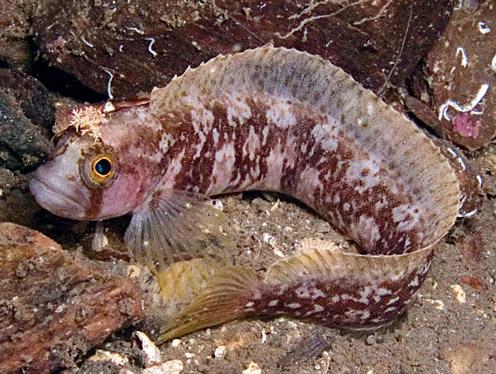
THE PEATY RUN-OFF from the streams above this side of the loch means that these sites can be fairly dark, so a good torch is necessary to spot all the butterfish and Yarrell’s blennies that like to conceal themselves, perfectly camouflaged, against the rocks.

Opposite, on the north side of the loch, is Slumbay Island. Down a stony slope, strewn with loch anemones, are dozens of swimming and hermit crabs and, again at around 25m, many tall sea-pens.
These sea-pens can grow as high as 2m, however, so at this site they are comparatively small. They still make a fantastic sight, as their feathery stalks bend gently with the tides.
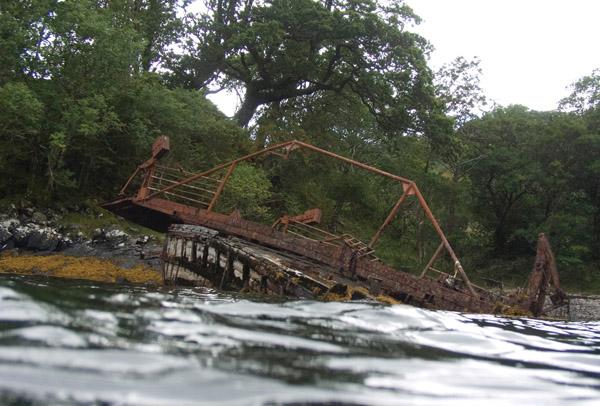
The old ferry, only half-submerged at high tide, can provide an amusing dive if you have a rust-loving buddy. Redundant and past any use, it has been left to rot on the north side of the loch, and is completely exposed at low tide.
The rusty skeleton is fun to have a poke around before heading off down the slope towards the centre of the loch, where the shingle seabed provides excellent camouflage for thornback rays.
Beyond the mouth of Loch Carron and slightly to the north lies the tiny rocky island of Eileen na Beinne.
Large pollack and wrasse swim up and over the kelp-line as you descend here to the rocky reef below, which is home to topknots, ling, dragonets and dozens of leopard-spotted gobies, quietly resting on little sandy ledges.
The cliffs that appear as you swim east provide a different environment, the cracks making wonderful homes for garishly coloured spiny squat lobsters, cushionstars and spiky urchins.
TOWARDS PLOCKTON lies Dun Craig. Follow the slope down over the kelp, and find the rocks and cliffs alive with cuckoo wrasse, dead men’s fingers and huge edible crabs.
Eventually the walls disappear, and so you may return along the seabed, covered in swimming crabs and many more of the beautiful white sea cucumbers. Keep a look out for dogfish, skate and thornbacks, all of which are often seen here.
Finally, for those days on which you’re not boat-diving, park up by the slip at North Strome and sample a few of the most colourful shore dives I have ever done in the UK.
The fierce tides that flow through the narrows here make the timing of these dives very important. At slack, swim straight out into the middle of the loch, where the mearl beds are covered with black brittlestars.
From here you can explore up or down the loch, circling and using the incoming or outgoing tides to bring you back to the jetty as slack finishes.
Alternatively, enter the water from the slip at high-water slack and head east. Keeping the wall on your left, explore the base of the cliffs, where there are flame-shells. These creatures cover themselves with bits of old shell and gravel, making them difficult to spot.
I was trying to photograph these flame-shells when I noticed movement out of the corner of my eye, and looked up to find a huge edible crab making a beeline for me. With his huge rounded claws raised, he looked like a muscle-bound prize-fighter, ready for anything.
I assumed that he was after the flame-shell I had been trying to photograph, and looking at the size of his claws I decided to back off. Ignoring the flame- shell, he continued to approach me.
I felt a little silly being so intimidated by a crab, and decided to try a bit of coercion myself.
With my eyes fixed very much on his claws, I began to nudge him out of the way with my camera flashgun, hoping that his huge pincers would not find the cable that joined it to the housing.
FINALLY, HAVING SEEN OFF this fierce crustacean, now sulking at the bottom of the wall, I decided to finish taking the photos I wanted.
This was only after I had manoeuvred myself to keep an eye on my adversary, should he launch a further attack.
Having finished taking my pictures, I let the outgoing tide gently usher me back to the slip. Heading the other way (west) is best done at low-water slack.
It is possible to do this dive out of Castle Bay, which is overlooked by the ruined castle on the hill.
Swim to the end of the headland and round the corner, fin along the wall and finally let the incoming tide bring you to the slip.
However, it’s a fairly long way, especially for squidgy lovers and photographers who like to linger.
I found it easier to enter the water off the slip, swim out a little, then head west over the huge blades of kelp, bent double by the ferocity of the last tide. You can then find the end of the wall across the other side of the neighbouring bay.
Dead men’s fingers and huge dahlia and plumose anemones cover these walls, which provide resting places for many different sorts of small fish and crabs. Testament to the fierce tides are the dead men’s fingers that not only grow on the walls but all over the seabed here.
Either return when your air supply suggests you should, or allow the end of slack and the incoming tide to bring you gently back to the slip.
The highlight of diving in Loch Carron came on my final dive. I had lost my buddy earlier and was just quietly hanging on a safety stop when, much to my delight and amazement, I was joined by the pair of young dolphins which continued to circle and play around me.
Entranced by these wonderful creatures, I decided not to photograph them but just to enjoy the moment and this experience, so rare in the UK.
Finally, my air much-depleted, I had to say goodbye and surface.
Because the opportunity to obtain air fills gets more difficult the further north you go, Loch Carron is an excellent place to base yourself for diving.
Dave Black, who owns 5 Bells Diving, is happy to do fills for visitors and will take a minimum of two divers out in his RIB, which goes out from the slip in North Strome. With many dive sites being so close to each other and with a small number of divers, trips can also be very personalised.
No-one could fail to be impressed with the diving in this beautiful loch.
A dolphin escort adds the final touch.
5 Bells Diving, Lochcarron, provides air-fills, training and RIB-diving from £25 a dive (£45 for two dives, £60 three), 01520 722 100
